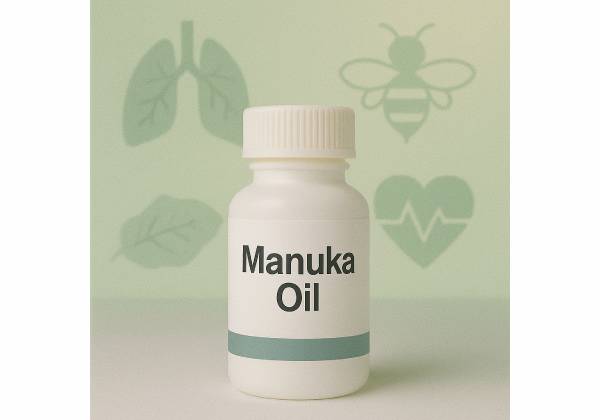
Manuka oil is the steam-distilled essential oil from the leaves and small branches of the New Zealand tea tree, Leptospermum scoparium. Unlike manuka honey, which is valued for methylglyoxal, the oil’s standout constituents are a family of β-triketones (such as leptospermone, flavesone, and isoleptospermone) alongside sesquiterpenes. These molecules give manuka oil notable activity against common skin microbes and biofilms, with emerging data for antiparasitic, antiviral, and anti-inflammatory effects. In practice, manuka oil is most helpful when you use it like a precision tool: dilute properly for skin, pair with barrier-supportive bases, and choose a batch with a verified chemotype suited to your goal (for example, high-triketone “East Cape” oil for antimicrobial tasks). This guide translates the science into clear, hands-on steps—how to select a quality oil, how to dilute it safely, what outcomes to expect, and where the limits are—so you can benefit from manuka oil without guesswork or gimmicks.
Key Insights
- Demonstrates broad antimicrobial and anti-biofilm activity in vitro; β-triketone-rich chemotypes tend to be stronger.
- Best everyday uses: diluted spot care for problem skin, adjunct care for feet and nails, and odor control in cleansers or deodorant bases.
- Typical skin dilution: 0.5–2% for face, 1–3% for body, up to 5% for short-term, localized applications; avoid undiluted use.
- People with eczema, very sensitive skin, or who are pregnant should use lower dilutions or seek clinician guidance; never ingest essential oils.
Table of Contents
- What is manuka oil?
- Does it work? Benefits and limitations
- How to use it and how much to apply
- Choosing quality and chemotypes
- Common mistakes and troubleshooting
- Evidence and research summary
What is manuka oil?
Manuka oil is an essential oil obtained by steam distilling fresh or gently dried foliage and twig tips of Leptospermum scoparium. The species grows throughout New Zealand; regional ecology and genetics shape the oil’s chemistry. Producers often describe chemotypes—consistent compositional fingerprints that track to geography and harvest—for example, β-triketone-rich oils from New Zealand’s East Cape versus sesquiterpene-leaning oils from other regions.
Key compositional points you’ll see on a Certificate of Analysis (CoA):
- β-Triketones (signature actives): leptospermone, isoleptospermone, flavesone, grandiflorone. These correlate with strong antimicrobial measures in lab tests.
- Sesquiterpenes: calamenene, cadinenes, caryophyllene, and others that add skin-feel, scent depth, and complementary bioactivity.
- Minor monoterpenes: typically lower than in tea tree oil, which partly explains manuka’s gentler aroma and often milder skin feel when diluted.
Why chemotype matters in practice:
- Skin and nail care: High-triketone batches tend to perform better for stubborn gram-positive bacteria on skin, malodor control, and adjunct nail care.
- Sensitive complexions: Lower-triketone, sesquiterpene-forward batches can be more comfortable in leave-on facial products at modest dilutions.
- Aromatics: Calamenene and related sesquiterpenes add balsamic, herbaceous warmth distinct from eucalyptus-like notes of tea tree.
Manuka oil is not the same as manuka honey. The oil is lipophilic and highly concentrated, meant for external, diluted use only. Honey is aqueous and edible, and clinical wound dressings use sterilized, medical-grade honey—not essential oil. Keep the two categories separate when planning care.
Does it work? Benefits and limitations
Broad antimicrobial and anti-biofilm activity (lab and ex vivo)
Well-characterized manuka oils inhibit a range of gram-positive bacteria (e.g., Staphylococcus aureus, including biofilm-forming strains) and selected gram-negative bacteria under laboratory conditions. β-Triketone content tracks with stronger minimum inhibitory concentrations in testing. Importantly for real-world skin and surfaces, several investigations show biofilm disruption and synergy when oils are combined with cleansing or debriding steps—useful for malodor control (feet, underarms) and as an adjunct in problem-skin routines.
Antifungal coverage
Formulations featuring manuka oil demonstrate activity against Candida species in vitro, with additional evidence of performance in multi-species biofilms common on skin and nails. For nails, results are gradual; pairing trimmed nails, regular debridement, and a carrier that can persist on the nail plate (balm, lacquer base) improves practical outcomes.
Antiviral and antiparasitic signals (experimental)
A β-triketone-rich oil has shown virucidal activity against HSV-1 and HSV-2 in cell culture. More recently, β-triketones and whole oil demonstrated ovicidal and acaricidal effects in a scabies model in vitro, highlighting mechanistic targets in parasite metabolism. These are promising leads, not consumer-ready cures; clinical protocols are still evolving.
Anti-inflammatory and photodamage moderation
Topical manuka oil reduced UV-B-induced skin thickening, wrinkle metrics, and inflammatory cytokines in a hairless-mouse model, suggesting potential as a cosmetic active when carefully diluted and paired with barrier-supportive bases. In day-to-day skincare, that translates to soothing adjunct in recovery balms and after-sun products—never a substitute for broad-spectrum sunscreen.
Odor control and cleansing
By lowering microbial load where sweat accumulates (feet, underarms), manuka oil can help reduce malodor when formulated into wash-off products (cleansers, soaps) and leave-on deodorant balms. Its aroma is warm, resinous, and less camphoraceous than tea tree, which many users prefer.
What manuka oil does not do
- It is not an ingestible “supplement.” Essential oils are not for internal use unless a clinician specifically prescribes and supervises.
- It is not a stand-alone cure for established infections of skin, nails, or scalp. At best, it is an adjunct alongside hygiene, debridement, drying the area, and—in medical cases—appropriate medications.
- It does not replace sunscreen or proven acne agents if you need those.
Bottom line
Expect modest, practical gains—cleaner skin ecology, calmer appearance, less odor—when you dilute correctly, choose the right chemotype, and use consistently. Overclaims or “one-drop cures” are marketing, not evidence.
How to use it and how much to apply
Dilution guidelines (external use only)
Essential oils are potent and should be diluted in a compatible base (carrier oil, cream, gel). Use a digital scale or at least a reliable dropper; assume 20–30 drops ≈ 1 mL as a rough conversion, but weighing is better for consistency.
- Face (leave-on serums/creams): 0.5–2% manuka oil. Start low if your skin is reactive.
- Body (lotions/balms): 1–3% for broad areas.
- Targeted, short-term spot use (thick skin, e.g., feet): Up to 5% for 7–14 days, then reassess.
- Rinse-off cleansers/soaps: 0.5–1.5% often suffices due to contact time plus surfactant action.
- Scalp tonics (leave-on): 0.5–1% in a light carrier (e.g., squalane or a fast-drying ester). Patch test first.
How to patch test
Apply a 1% dilution to a small area of the inner forearm twice daily for 3 days. Watch for persistent redness, itching, or irritation. If clear, proceed to your intended dilution on the target site. If you react, stop and trial a lower dilution or consider a different chemotype.
Formulation tips for comfort and efficacy
- Pair manuka oil with barrier helpers—ceramides, glycerin, panthenol, and light occlusives—to keep skin calm.
- For nails and feet, a balm or lacquer base increases contact time. Trim nails and dry feet thoroughly before application.
- In deodorant balms, combine with zinc salts or magnesium hydroxide for pH modulation and odor binding.
- Avoid strong acids or retinoids in the same step; separate morning/evening if you use both.
Application rhythms that work
- Acne-prone areas: After cleansing, apply a 0.5–1% diluted product once daily at night for 2–4 weeks before judging results.
- Foot and nail care: Daily use for 8–12 weeks, with weekly grooming, improves odds of success.
- After-sun soothing: Use a 0.5–1% dilution in an aloe- or panthenol-rich base for 1–3 days post-exposure if skin is intact.
What to avoid
- Undiluted application on skin, eyes, mucosa, or genitals.
- Internal use (swallowing or capsules).
- Continuous high-strength use beyond several weeks on the same area without breaks—rotate with bland care to protect barrier health.
Storage and shelf life
Keep bottles tightly closed, away from light and heat. Use within 12–24 months of opening. If the aroma becomes sharply different or the oil feels irritating at previously tolerated dilutions, consider it oxidized and discontinue.
Choosing quality and chemotypes
Read the CoA (Certificate of Analysis)
A reputable supplier provides a batch-specific CoA listing major constituents and showing the β-triketone percentage. For antimicrobial-leaning goals, look for a triketone-rich chemotype; for leave-on facial comfort, a moderate-triketone or sesquiterpene-forward profile may be more comfortable.
Key markers and what they mean
- Leptospermone / isoleptospermone / flavesone: Signature β-triketones. Higher totals often predict stronger lab antimicrobial results.
- Calamenene and other sesquiterpenes: Contribute to soothing feel and scent complexity; may temper the sharpness of high-triketone oils.
- Peroxide value / oxidation status: Some suppliers provide stability metrics; fresher oils tend to be milder on skin.
Sourcing and authenticity
- Prioritize New Zealand origin with traceable harvest regions and independent testing. Manuka oil production is smaller than honey, but adulteration remains a risk in global markets.
- Prefer steam-distilled oils over solvent-extracted aromatics for topical use.
- Buy smaller volumes you can finish in a year rather than a large bottle that will oxidize before you use it.
Chemotype selection by task
- Problem skin / malodor control: High-triketone chemotype; formulate at 1–3% in body products.
- Daily facial care: Moderate-triketone with richer sesquiterpenes; start at 0.5–1%.
- Scalp / beard care: Balanced profile at 0.5–1%, paired with lightweight carriers (squalane, MCT).
- Household cleansing concentrates: High-triketone oils blend well with surfactants for targeted odor and surface biofilm tasks (avoid diffusion into occupied rooms—see safety).
Comparing manuka oil with tea tree oil
- Aroma: Manuka is warmer, woodier, less camphoraceous.
- Chemistry: Manuka’s β-triketones versus tea tree’s terpinen-4-ol dominance.
- Skin feel: Many users find properly diluted manuka gentler-smelling and cosmetically easier to wear in leave-ons; both require patch testing.
- Use case split: Tea tree remains a strong all-rounder; manuka excels when triketone-driven activity or a different aromatic profile is desired.
Label cues that inspire confidence
Batch number, harvest region, GC-MS profile, allergen statement, best-by date, and storage guidance. Absence of these details is a red flag.
Common mistakes and troubleshooting
Using it neat (undiluted) on skin
Even though anecdotal reports abound, undiluted essential oils increase the risk of irritant or allergic contact dermatitis. Always dilute. If you’ve already reacted, stop, switch to bland emollients (petrolatum, simple ceramide creams), and avoid the area until fully recovered.
Confusing manuka oil with manuka honey
They are different tools. Honey dressings for open wounds are medical-grade, sterile products. Manuka oil belongs in diluted, closed-skin applications (or rinse-off cleansers). Don’t apply grocery honey to open wounds, and don’t use essential oil internally.
Too strong, too soon
Jumping to 5% on the face or delicate skin almost guarantees pushback (stinging, redness). Dial back to 0.5–1%, add barrier helpers, and give it 2–4 weeks before judging.
No structure for nail goals
Onychomycosis is slow. Clip and thin weekly, keep nails dry, and use a high-persistence base (balm/lacquer) daily for 8–12 weeks before you evaluate. If the nail is painful, distorted, or rapidly worsening, seek medical care—topicals may be insufficient.
Layering with strong actives at the same time
Applying manuka oil and an acid/retinoid in the same step increases irritation risk. Alternate mornings/evenings or separate by days.
Using diffusers around pets or infants
Essential oil aerosols can irritate airways—especially for cats, small dogs, birds, infants, and anyone with asthma. Skip diffusers in shared spaces; if you still diffuse for scent, keep it brief, low, and in well-ventilated, adult-only rooms.
Interpreting “natural” as “risk-free”
All potent plant extracts can irritate or sensitize. Respect dilutions, patch test, and build in off days for leave-on use.
If you experience irritation
Stop immediately. Rinse with a light carrier oil, then wash with a gentle cleanser. Resume only after skin normalizes, at half the previous dilution, or switch to a different chemotype.
Evidence and research summary
Chemistry and chemotypes
Field surveys and analytical work established that triketone-rich chemotypes—notably from New Zealand’s East Cape—contain >20% total β-triketones with stable seasonal profiles. These signatures align with stronger antimicrobial outputs in lab testing and underpin commercial interest in batch-verified oils.
Antimicrobial and anti-biofilm data
Narrative and systematic overviews collate manuka oil’s broad antimicrobial range, highlighting activity against Staphylococcus aureus and Listeria monocytogenes and tangible biofilm disruption in vitro and on food-contact surfaces. Anti-biofilm behavior is particularly relevant to malodor control and adjunct skin hygiene, where microbes organize into protective communities.
Antiviral and antiparasitic findings
A β-triketone-rich oil demonstrated virucidal activity against HSV-1/HSV-2 in cell culture. Recent mechanistic work reports that whole oil and purified β-triketones can kill scabies mites and eggs in vitro, likely via inhibition of 4-hydroxyphenylpyruvate dioxygenase (HPPD), a target also known from herbicidal science. While these results are encouraging, clinical protocols for humans require rigorous trials.
Anti-inflammatory and photoprotection signals
In a UV-B hairless-mouse model, topical manuka oil reduced inflammatory cytokines and wrinkle metrics while preserving collagen architecture, suggesting cosmetic promise as a soothing adjunct when properly diluted. Translation to humans supports its inclusion at low percentages in after-sun and barrier-support products—paired with sunscreen in daytime routines.
Comparative perspectives
Reviews spanning many dermatology-oriented essential oils position manuka alongside tea tree, thyme, and others. Manuka’s differentiator is the β-triketone cluster, offering a complementary mechanism to terpinen-4-ol-dominant oils and potentially broadening formulation options when sensitivity or aroma preferences rule out alternatives.
Safety themes across studies
At cosmetic dilutions, manuka oil is generally well tolerated on intact skin in short-term use. Risk rises with higher concentrations, frequent use on delicate areas, pre-existing barrier damage, or oxidized product. Standard precautions—patch testing, conservative percentages, and avoiding mucosa/eyes—remain the best predictors of success.
What we still need
- Head-to-head human trials comparing manuka-based leave-ons versus standard acne, foot, or nail protocols.
- Dose–response mapping by chemotype in cosmetic-grade leave-on products.
- Longer-term sensitization data in everyday users following realistic routines (e.g., 0.5–1% leave-on for 12 weeks).
Practical synthesis for readers
Pick a verified chemotype, dilute to 0.5–2% for face or 1–3% for body, build barrier support into your formula, and evaluate results after 2–4 weeks. Use short, focused bursts at higher dilutions for stubborn foot or nail goals. Treat manuka oil as an adjunct—not a replacement for sunscreen, moisturizers, or clinician-directed care when needed.
References
- Essential oils from New Zealand manuka: triketone and other chemotypes 2004 (Experimental Study)
- Mānuka Oil—A Review of Antimicrobial and Other Medicinal Properties 2020 (Review)
- Antimicrobial and anti-biofilm activity of manuka essential oil against Listeria monocytogenes and Staphylococcus aureus 2022 (Experimental Study)
- Topical Administration of Manuka Oil Prevents UV-B Irradiation-Induced Cutaneous Photoaging 2013 (Experimental Study)
- Virucidal activity of a beta-triketone-rich essential oil of Leptospermum scoparium (manuka oil) against HSV-1 and HSV-2 in cell culture 2005 (Experimental Study)
Medical Disclaimer
This article is for educational purposes and does not replace personalized medical advice, diagnosis, or treatment. Do not ingest essential oils. Use manuka oil only in appropriate dilutions for external applications on intact skin, and stop if irritation occurs. People who are pregnant or breastfeeding, have chronic skin conditions, are sensitive to fragrances, or plan to use essential oils on children should consult a qualified healthcare professional before use. For suspected infections, non-healing wounds, or nail disorders that worsen, seek medical care rather than self-treating with essential oils.
If you found this guide useful, please consider sharing it on Facebook, X (formerly Twitter), or any platform you prefer, and follow us for future evidence-informed explainers. Your support helps us continue producing careful, people-first content.










